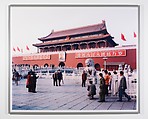Tien An Men, Beijing
Thomas Struth German
Not on view
Tien An Men, Beijing exemplifies Struth’s ability to fold different historical moments into the perpetual present of the photographic image. The setting is Beijing’s central square, with its fifteenth-century Gate of Heavenly Peace, where the masses traditionally assembled to hear imperial pronouncements. Over the central portal to the Forbidden City (an entrance once reserved for the emperor) hangs a
gigantic portrait of Mao commemorating the spot where the Communist leader proclaimed a new China in 1949.
Asian tourists and visitors mill through the space while a young woman poses for her picture beneath a marble lion and Mao’s watchful gaze. Struth’s trenchant pairing of two portraits—one an official likeness of power, the other a snapshot of an anonymous citizen—reveals an invisible quotient of the picture, however, as June 4, 1989—the infamous date when the soldiers of the People’s Liberation Army opened fire on unarmed students protesting for democracy. Struth’s photograph is not a simple condemnation of the single country to survive the fall of Communism during the late 1980s but a more complex, ambiguous meditation on the potential of the individual subject caught in the flow of history.
Due to rights restrictions, this image cannot be enlarged, viewed at full screen, or downloaded.

